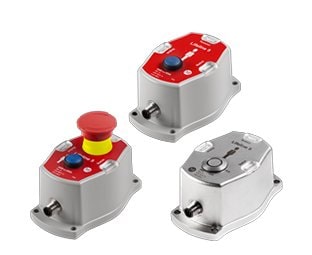
Blog > Automation > Using E-Stops Over Longer Spans
Using E-Stops Over Longer Spans
9/14/21 | Tom Hopkins, Rexel Technical Consultant

Blog > Automation > Using E-Stops Over Longer Spans
9/14/21 | Tom Hopkins, Rexel Technical Consultant
We all know emergency stops or e-stops on automated machinery are a requirement. But what is the best way to apply and position them, especially for long spans?
The ISO 13850 standard is a great resource in understanding the correct application of E-Stop devices. However, spacing between e-stop buttons on a piece of equipment is not defined. It’s up to your design team to determine the risks and the position of the buttons. For a longer piece of equipment how far is appropriate?
The related passage from the standard below:
4.4.2 An emergency stop device shall be located at each operator control station, except where the risk assessment indicates that this is not necessary, as well as at other locations, as determined by the risk assessment. It shall be positioned such that it is readily accessible and capable of non-hazardous actuation by the operator and others who could need to actuate it. Measures against inadvertent actuation should not impair its accessibility.
We know you must do a risk assessment. This is a VERY important step that I’ve discussed in other posts. How do you know what to do if you don’t have a full understanding of the risks, right? So, take the time and do it correctly.
Let’s assume you have done a risk assessment and are dealing with a long conveyor. Because employees are loading and unloading material along the whole length, every point along one edge of that conveyor is a potential risk in your application. You cannot guard that edge.
The best E-Stop device, in this case, is a pull cable attached to a safety switch. It’s likely you have seen these if you have spent much time in industrial facilities. If there is a safety demand, a person can yank on the cable that will deflect the safety switch it is connected to and stop the machine. They are a solution that is offered in section 4.5 of the ISO 13850 standard.

In my experience, however, traditional cable pull e-stops are not always popular. Why?
As far as setup, traditional devices are simple dry contact safety switches that require a couple of people to set the spring tension just right. If the tension is too strong or slack, it will trip. And with a longer line, you’ll need two people a fair distance apart; one person at the tensioner and one person at the switch, trying to communicate effectively.
Any time you have a safety device that causes heartache for maintenance personnel or operators, there is a higher probability it’s going to be defeated, so you want to choose the right device.
Fear NOT, there is a solution in the latest generation of cable pull switches. The newer Allen-Bradley® Lifeline™ 5 series from Rockwell Automation® solves the above problems and adds information gathering capability

- No more nuisance trips.
o It’s an intelligent solid-state device, using a load switch to determine tension level.
o It only trips with fast changes in the tension created by a yank on the cable
o It will not trip for slow tension change (e.g., if leaning into the cable or a temperature change induced tension change).
- One person can set it up.
o It has bright LEDs that can be seen from a long distance. One person can tension the line from a distance and watch the LEDs flash to indicate when it’s set correctly.
- Versions for corrosive areas.
o A stainless-steel body option is available.
- Know it’s going the trip BEFORE it shuts the machine down.
o Tension status can be seen on the LED and collected over the wire to a PLC.
o Trip status can also be seen on an LED or over the wire.
E-stops, switches, and everything in between, we’re here to help. Our machine safety and automation specialists can help you address challenges and offer expert advice. Contact us today!